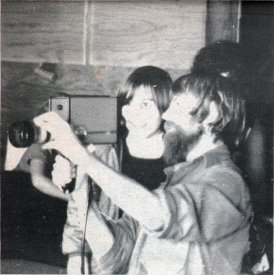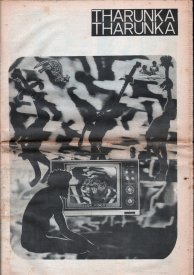The following material is from the Bush Video special issue of Tharunka XL-5, August 7, 1973, p.2. It has been edited only to the extent that I have fixed some typographical errors.
------------------------------------------------------------------------------------------------
Hello ... this is BUSH VIDEO transmitting some printed messages. We are people who are putting our heads into the common information space of video communication. We define video as a tool for the reception, codification, and transmission of audio/visual information, and as the technological extension of the human brain's memory/image processing, storage, and retrieval system. After consciously and unconsciously, seeing and dreaming, video and metavideo 24 hours a day for the last four months we are now giving a brief report of “these instrumented revisits to paradise” (Bucky) and the discovered educational, social integrational, global culture participational, and simply world turning-on potentines of video communication which make the present pre-programmed, one-way broadcast TV as obsoletely relevant as the town crier.
Realisation of the total ecological interdependence of all living forms on the planet requires our responsibility to globally coordinate our energy modulating strategies ... which requires a planetary communication medium and a universal language for world literacy. Joseph EI Khourey’s article “Alchemy of Communication” outlines the tradition of this hermetic quest evolving to video as the contemporary alchemic tool.
It seems to us that video is the first of a family of a new generation of universe communication tools – probably as revolutionary as Gutenberg's printing press – which will expand the field of man's knowledge in unprecedented forms.
Mick Glasheen’s “Towards a General Theory of Communication” states a definition of communication as a sharing of conscious experience of energy and his “Topological Videospace” indicates a conceptual framework of inside-outing one surface Klein bottles for video information considered in terms of four communication processes – reception, codification, transmission, and transaction of messages.
Similarly to Noam Chomsky’s every child reinvents language when learning it-theory, video languages have yet to be invented, let alone vidiated. Thus, at the moment, video is a vast educational program to be processed (or process to be programmed) and most of our work is heuristic probing into video communication potentials.
The primary areas for video exploration are proposed to be:
(1) Video as Personal articulation.
(2) Video as Social interaction.
(3) Video as cosmic integration.
VIDEO AS PERSONAL ARTICULATION
Video as prosaic or harmonic articulation for the spontaneous investment of the imagination-gestating intellectual increments of experience.
Video as self-actualizing, meditational tool for reality projections e.g. self-made videospaces as empty memory theatre for staging consciousness transformations (see Joseph's “Memory Theatre”) and for insertion of specific vidiations to be played with by self or others invited into the theatre.
Synthetic video/music translations (video art).
Video therapy (cybernetic acupuncture?).
Video diaries of personal evolutions.
VIDEO AS SOCIAL INTERACTION
Video as social monitors (Social Early Warning systems similar to DEW - Distant Early Warning system for missile detection) for detection of evolutionary changes in societies.
Video as tool for initiation of social evolutionary strategies. E.g. “Challenge for Change” type projects (cf. Warwick Robbins and Tom Zubrycki's articles).
Video as tool for social intercommunication and information feedback - consciousness as communal bond matrices.
Video as anthropologic tool for world cultural integration. e.g. Videospace/time realization of Australian aboriginal dreamtime.
BUSH VIDEOPROGRAM PROCESS
We are primarily concerned with self educational/experimental video software and hardware research, production and display.
(a) SOFTWARE
Research
(1) Metavideo: Design of generalized video languages for universal human communication and programming of a universe image information integration tool.
(2) Design of generalised video languages for operational situations.
Suggested curriculum for video Design Science Synergetics of TV, the mathematics and physics of TV, Videospace Topology and Projective Geometry, Cybernetics and Video Epistemology Communication (Video Information Theory), Life and Light, Structuralist Mythology Programming, World Community of Interests and the Theory of Games (Von Neumann), Media Ecology.
(3) Design of specific video languages for immediate educational, industrial and social use. Suggested educational video research subjects:- Synergetics, General Systems Theory, Physics, Chemistry, Geology, Biology, Ecology, Meteorology, Sources of Energy, Political Geography, Ergonomics, Production Engineering.
Productions
Video productions are considered not as static products but as process reviews which can still evolve from viewing feedback.
(1) Personal articulations of video-reality projections.
(2) Social interactions and consciousness mixing. Documentation of emerging culture/life style as well as being an integral part of it (specifically concerned with the post-Nimbin community), Inventory of living Australian aboriginal culture (life/style, language, myth/song) as an eco-model of world game playing community, Alternative news service, World culture mix matrix.
(3) Cosmic integration (?) - production of a comprehensive series of “Universe Scenarios” or assisting world literacy regarding world resources and man’s function on the planet (educational programs as previously listed).
(b) HARDWARE
Research
(1) Design of a universe image information integration tool for recording, processing, storing and retrieving audio/visual information from a computerized image bank of accumulated images of man's cultural evolution.
(2) Research (if possible), into developments in pertinent technologies e.g. photography (especially infra and ultra naked sense reception spectrum), electron microscopy, fiber optic cable information transmission, 3D holographic display, laser video projection, radio interferometry, graphic computer systems.
(3) Progressive survey of videotools as they become available. Test, experiment and feedback performance information on 1/2" videotape systems.
(4) Design modifications to presently available equipment for preferred functions.
(5) Research Slushware i.e. Organic hardware and Media Ecology.
Production
It is proposed to establish an experimental video workshop as a teaching-learning situation.
Design and production of originally invented/modified videotools e.g. Chrominance synthesizer, 4-gun Read/write tube, 1/2” vidicon tube, cox box (for topological transformation of videospace), comprehensive mixing facility (at least mixing 2 VTR's, at most mixing 6), Electronic video experimentation, feedback loop exploration, subjective color exploration, (a) Black/white revolving discs, (b) Land color theory, Mono- to color converter via filter-wheel, EEG Alpha-wave video modulations.
BUSH VIDEO FACILITY
It is proposed to expand the existing facility to include color mixing and editing functions with additional experimental hardware. The facility will be portable and will serve as a partially mobile basis for taking the experiment out into the community. The facility will operate within a cultural context ranging from supporting community video projects, community arts projects, individual artists and colleges teaching television courses. It will do this by supplying a creative experimentation and learning situation and display venue for the software produced in a centralized location and a travelling facility touring communities, arts festivals, colleges and universities.
There is still an equipment shortage – indicated by the number of people who have used and want to use our equipment. There is a large amount of equipment, which has had nowhere near the kind of use that Bush Video’s equipment has had, in the Universities and educational institutions – we suspect that it needs liberating – possibly a nationally co-ordinated liberation front – Can AUS use its influence here? There have been a lot of ideas floating around about a campus electric newspaper and a Travelling Show to tour the campuses. We are interested in both these ideas, but we haven't the resources to do them alone. A liberation of campus equipment would make them more feasible.
Access the video tool on your campus. It is in the faculty cupboards for restricted educational use. If you can get to use it we would like to tour the campus circuit and meet and work with you. Bringing our mobile studio (the workshop centre) and tapes from other places (the distribution). We can plug into an existing situation on campus for one week and use video to produce a groups eye view by
1. Make programmes.
2. Playing back programmes in video theatre.
3. Play back tapes from other campuses
and [developing] a universal language. Video may be the tool to create that language.
You can use/access this tool in your situation.
On campus, many faculties have portapaks for restricted education use. Derestrict this. If you get access under a research pretext we would like to work with you and see your tapes.
We would like to tour campuses to:
Energise existing context.
Work and share experience in video.
Disseminate our skills.
Show tapes from other cities.
Take tapes to the next stop for showing.
BUSH VIDEO PEOPLE: Joseph El Khourey, Mick Glasheen, John Kirk, Jonnv Lewis, Ann Kelly, Melinda, Tom Barber, Anna Soares, Martin Fabinyi, Sri Richard, Mad Jack Meyer, Fat Jack Jacobson, Karl Wheelbarrow, Brian Williams, John Sissond, Jim McDonald, Damian. - Wednesday, August 8, 1973.
VIDEO CONTACT DIRECTORY - SYDNEY - AUGUST 1973
The names and addresses of those people in the directory have been edited down to those WORKING WITH video, and is intended to induce interaction and exchange of information and tape. If you feel you have been left out, write to us, “Bush-Video”, 31 Bay Street, Glebe, telling us what you're into. On an international level it would be good to plug into the Video Exchange Directory, C/- Image Bank, 4454 West 2nd Street, Vancouver 8, B.C., Canada, who publish regularly a world directory. Let it flow.
Aggy Read, C/- Film Dept., Flinders Uni, Bedford Park, Adelaide.
Bush-Video, 31 Bay Street, Glebe, Sydney. Phone 660-2684.
Bert Deling and Sasha Trikojous, “Eurutta” Sages Road, Baxter, Vic.
“Challenge for Change”, Warrick Robbins and Marlene Matteson, 21 Palm Street, St. Ives, Sydney. Phone 440-8622.
Elizabeth Cook, Chisholm College, La Trobe Uni, Bundoora, Vic. 3083.
Frank Wingham, Box 284 P.O., Grafton.
Gail Haglund, 132 Auburn Road, Auburn, Hawthorn, Melbourne Vic.
George Klein, Tasmanian College of Advanced Education, Box 1415P GPO Hobart, 7001 Tas.
lan James, 28 Norfolk Street, Fremantle 6160 W.A.
Ian Batty, 81 Liddiard Street, Hawthorn Vic.
John Hughes, “Winterborn”, Mountain Road, Cockatoo Vic.
John Hansen, Box 85 P.O. Belgrave, Vic.
Phil Noyce, 20 Alfred Street, Annandale.
Peter Fredericks, 60 Foley Street, Kew, Vic.
Peter Lewis, Bristol Channel, 2-3 Broad Plain, Bristol UK.
Rodger Foley, 112 Riley Street, East Sydney.
Richard Dunn, 19 Victoria Road, Swindon, Wilts UK.
Warren Hannigan, 3 Help Street, Chatswood.
Tom Zubrycki, 35 Stephen Street, Balmain, phone 827-1546. Or C/- Sociology Dept., UNSW.
Carey Court, 318 Station Street, North CarIton. 51-6811 (work).
Jon Sunderland, C/- 13 Lynette Avenue, Beau Maris Vic. 3193. 99-3881.







